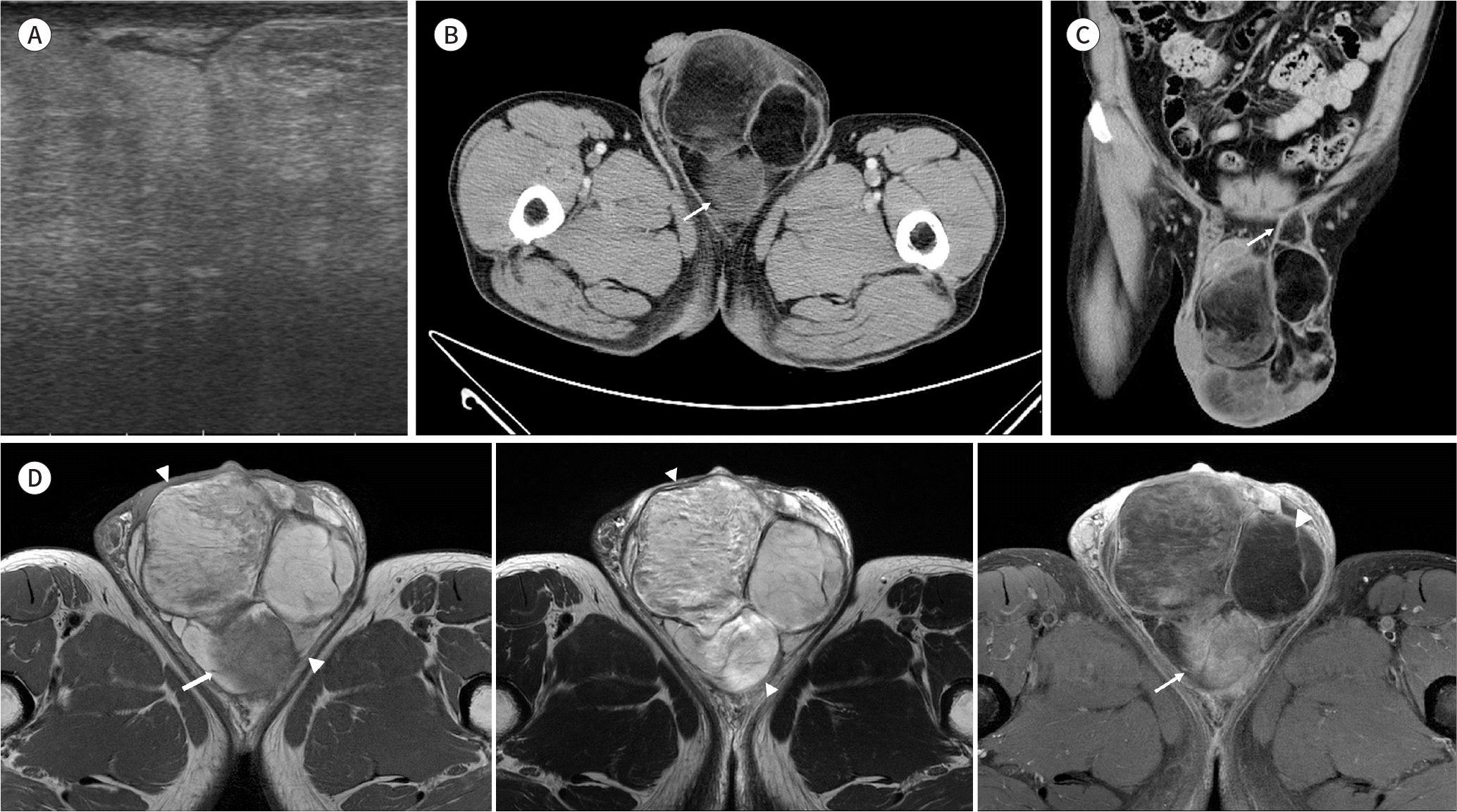Abstract
Liposarcoma located in the scrotum is a very rare, and to our knowledge, only a few cases have been described in the radiologic literature. Clinically, scrotal liposarcoma manifests as a painless, slow-growing mass, which can be misdiagnosed as inguinal hernia, scrotal hydrocele or lipoma. Here, we present a case of scrotal liposarcoma. On CT and MRI, it manifested as a predominant fat-containing mass with heterogeneously enhancing soft tissue.
References
1. Beccia DJ, Krane RJ, Olsson CA. Clinical management of non-testicular intrascrotal tumors. J Urol. 1976; 116:476–479.

2. Wolfman DJ, Marko J, Gould CF, Sesterhenn IA, Lattin GE Jr. Mesenchymal extratesticular tumors and tumorlike conditions: from the radiologic pathology archives. Radiographics. 2015; 35:1943–1954.
3. Enzinger FM, Weiss SW.Liposarcoma. In Enzinger FM, Weiss SW, eds. Soft Tissue Tumors. 3rd ed. St. Louis: Mosby;2006. p. 431–466.
4. Patel NG, Rajagopalan A, Shrotri NS. Scrotal liposarcoma – a rare extratesticular tumour.JRSM Short Rep. 2011; 2:93.
5. Woodward PJ, Schwab CM, Sesterhenn IA. From the archives of the AFIP: extratesticular scrotal masses: radiologic-pathologic correlation. Radiographics. 2003; 23:215–240.
6. Alyousef H, Osman EM, Gomha MA. Paratesticular liposarcoma: a case report and review of the literature. Case Rep Urol. 2013; 2013:806289.

7. May M, Seehafer M, Helke C, Gunia S, Hoschke B. [Liposarcoma of the spermatic cord–report of one new case and review of the literature].Aktuelle Urol. 2004; 35:130–133.
Fig. 1.
59-year-old male patient with scrotal liposarcoma. A. An ultrasonographic image reveals a heterogeneous, hyperechoic mass in the left hemiscrotum. B. An axial contrast-enhanced CT image shows heterogeneous enhancement of septal and soft tissue components (arrow) in the tumor. C. A coronal contrast-enhanced CT image shows a left scrotal tumor extending along the left spermatic cord (arrow). D. An axial T1-weighted MR image (left) shows a predominantly high-signal intensity mass (arrowheads) with low-signal septa and solid component (arrow) in the left hemiscrotum. An axial T2-weighted MR image (middle) shows a large, predominantly high-signal intensity mass (arrowheads) in the left hemiscrotum. An axial contrast-enhanced T1-weighted, fat-suppressed MR image (right) shows the loss of signal in the fatty portions (arrowhead) and enhancement of the soft-tissue component (arrow) of the mass. CT = computed tomography, MR = magnetic resonance

Fig. 1.
59-year-old male patient with scrotal liposarcoma. E. Gross pathologic specimen shows a 16 × 13 cm, yellow-brown, lobulated tumor with hemorrhagic foci. F. Microscopic assessment of the pathologic specimen reveals marked variation in adipocyte size, compatible with an atypical lipomatous tumor. High-power photomicrograph shows atypical hyperchromatic cells (arrows), another characteristic of an atypical lipomatous tumor (he-matoxylin-eosin staining; original magnification, × 100, × 200).





 PDF
PDF ePub
ePub Citation
Citation Print
Print


 XML Download
XML Download